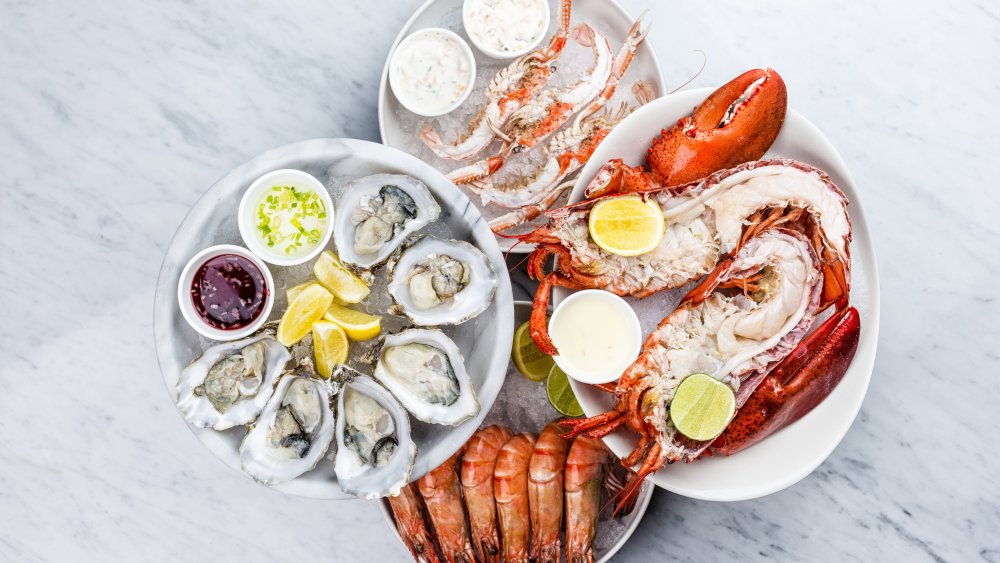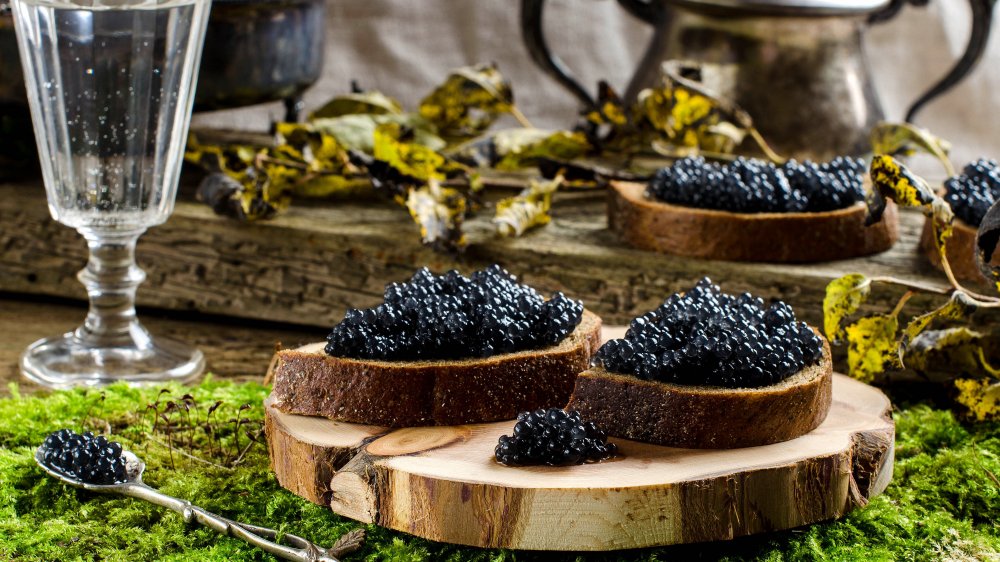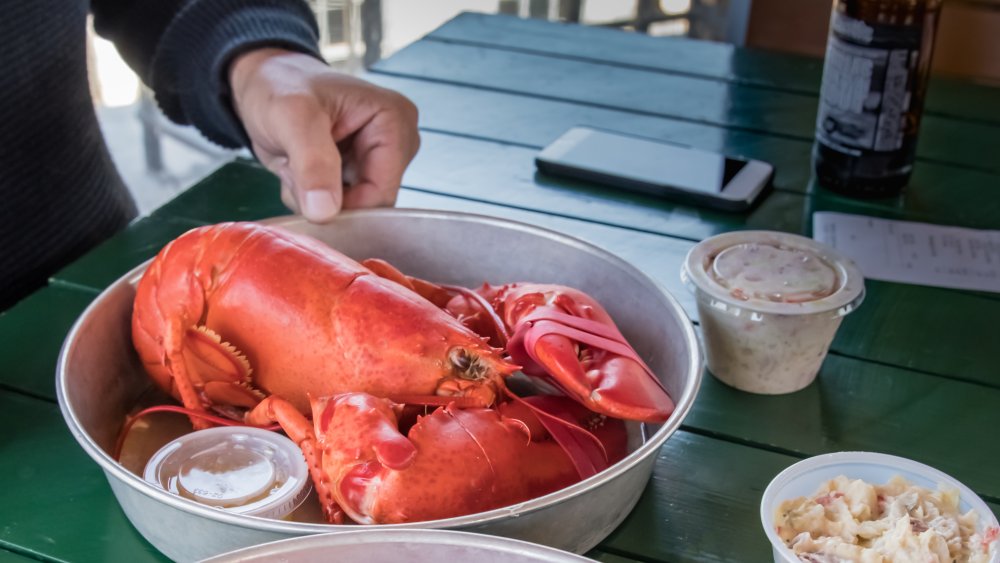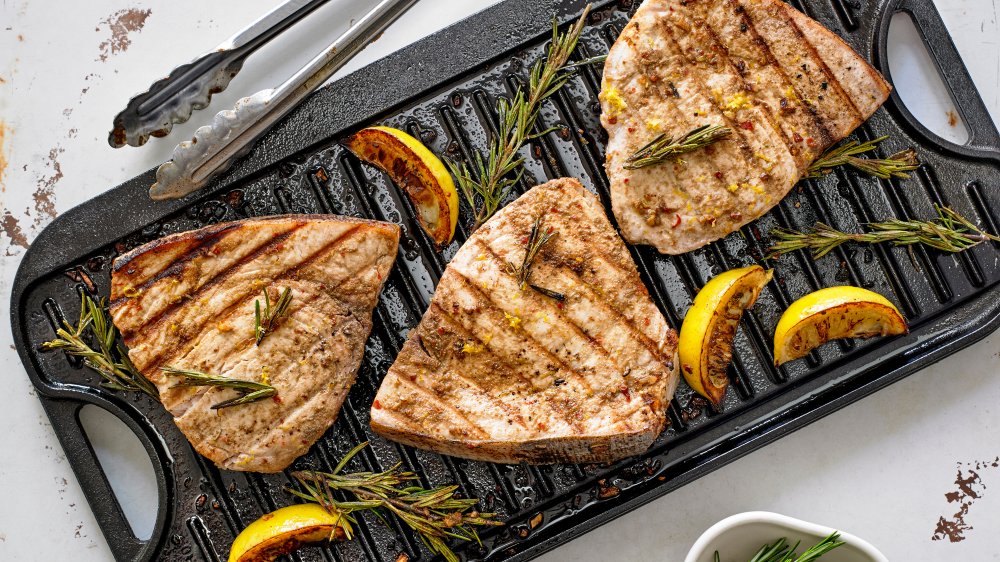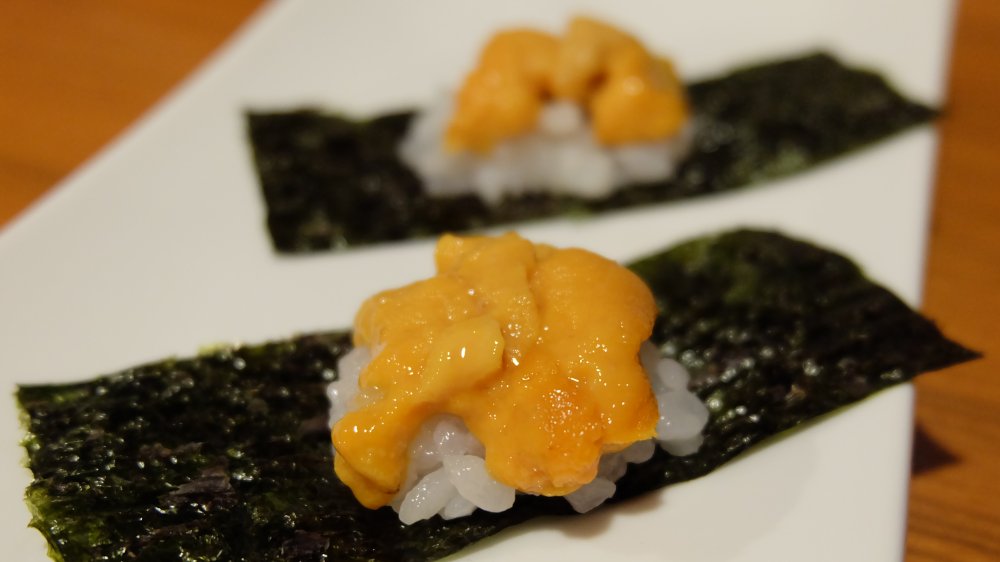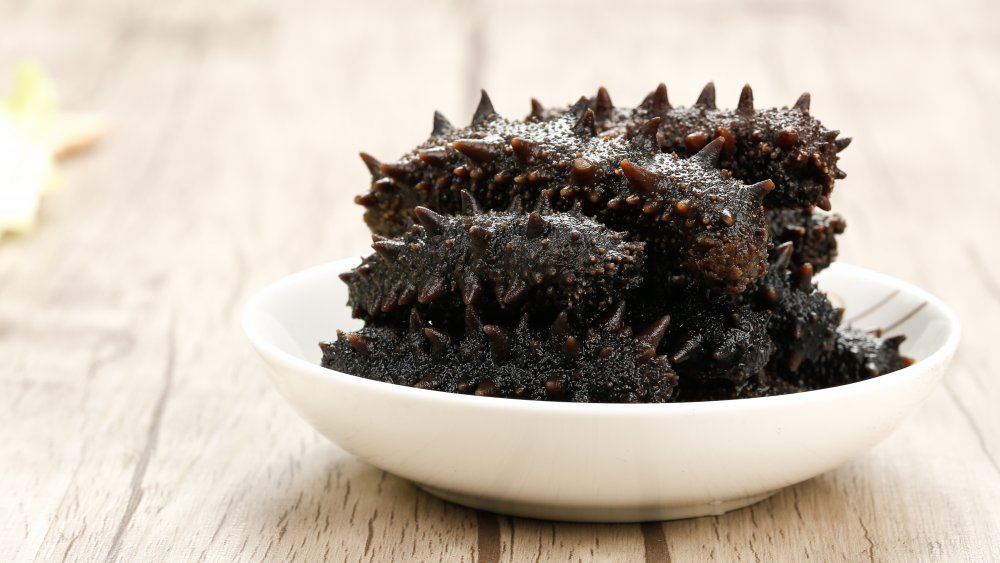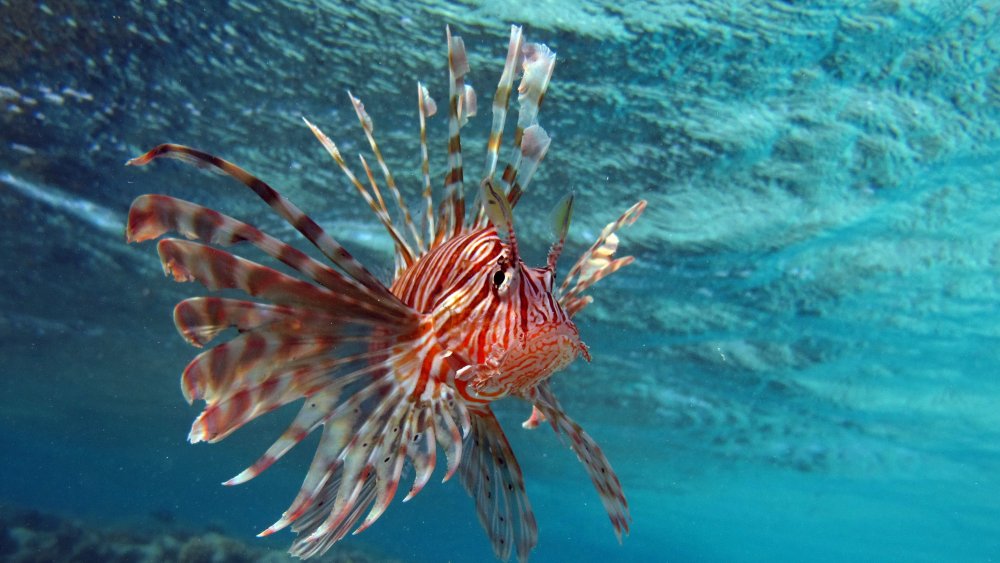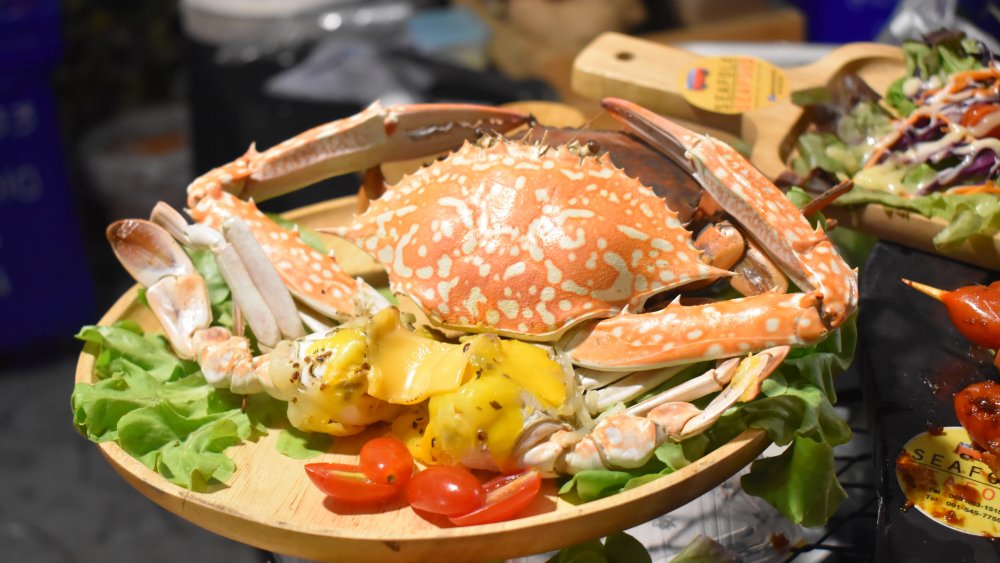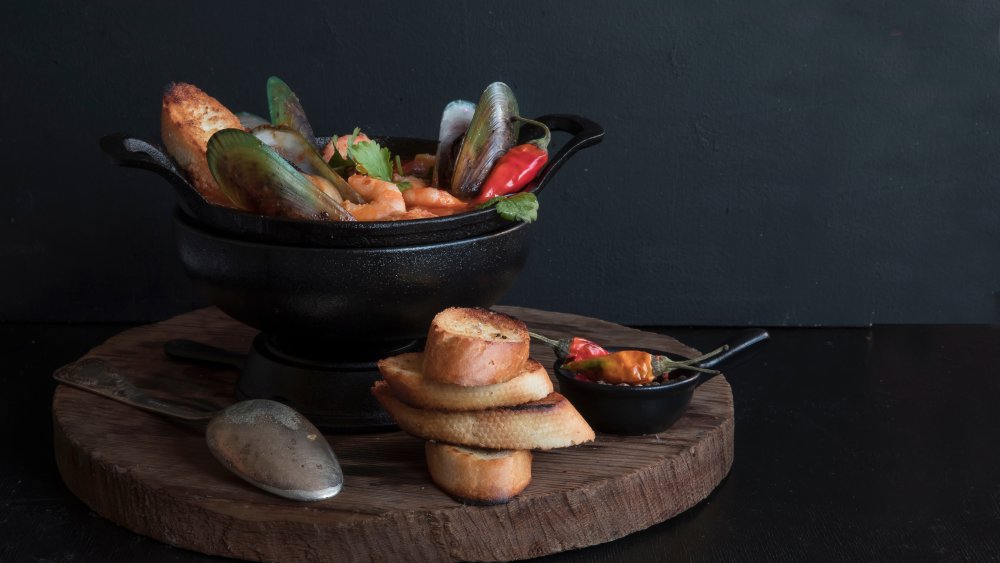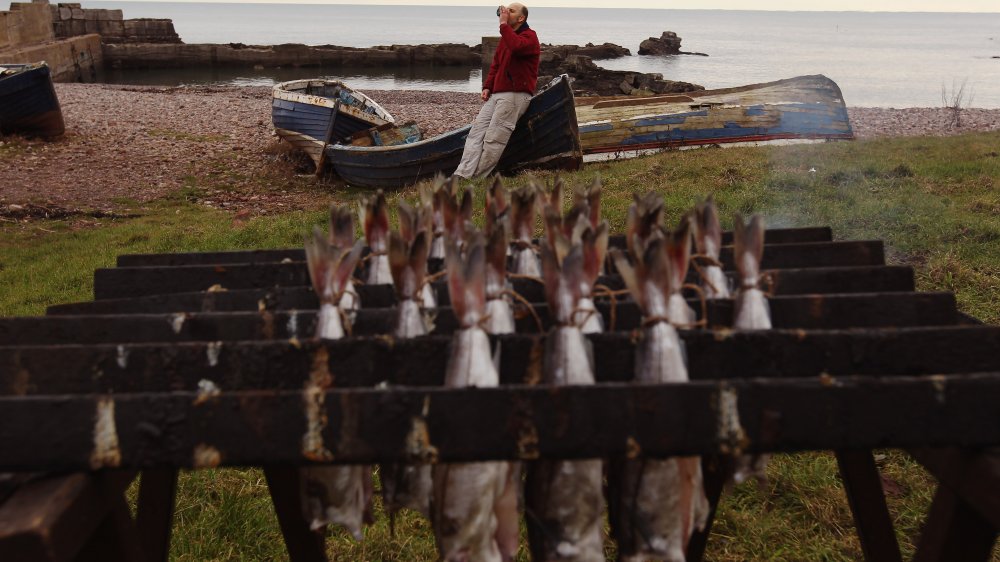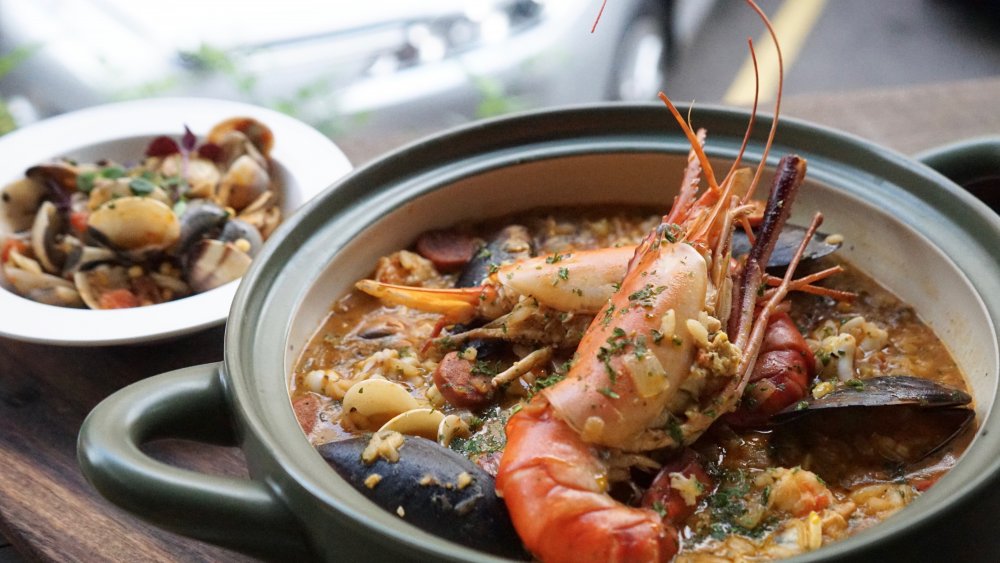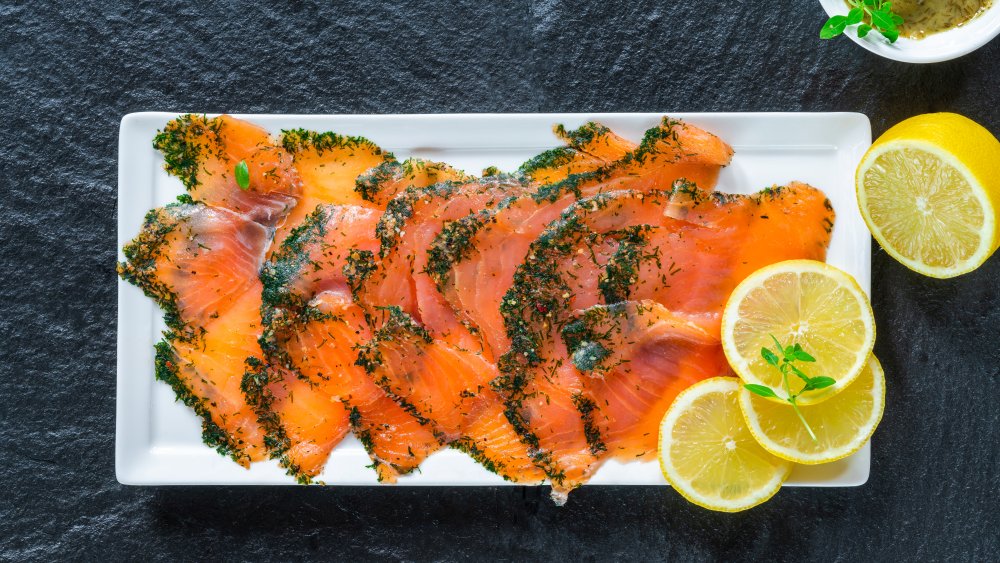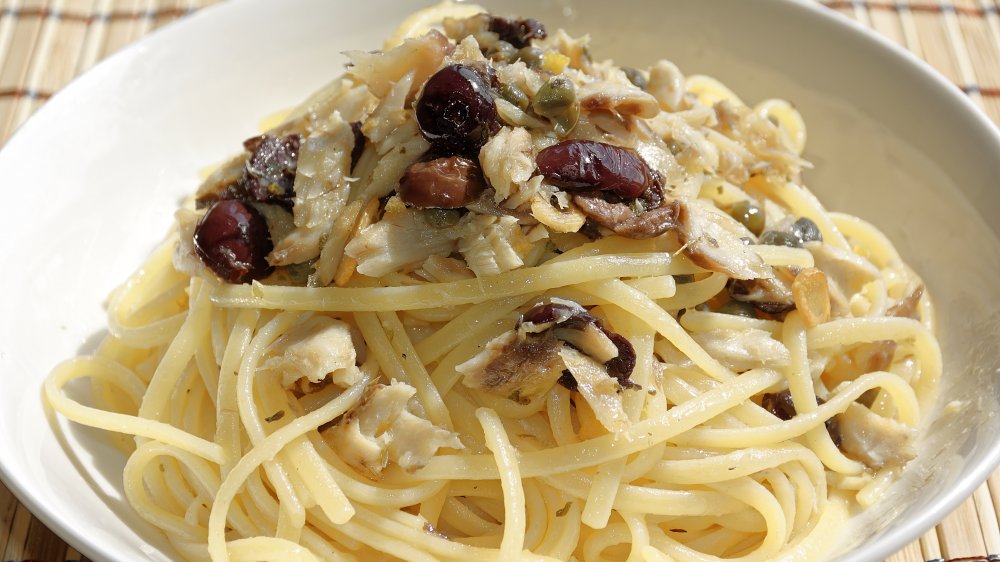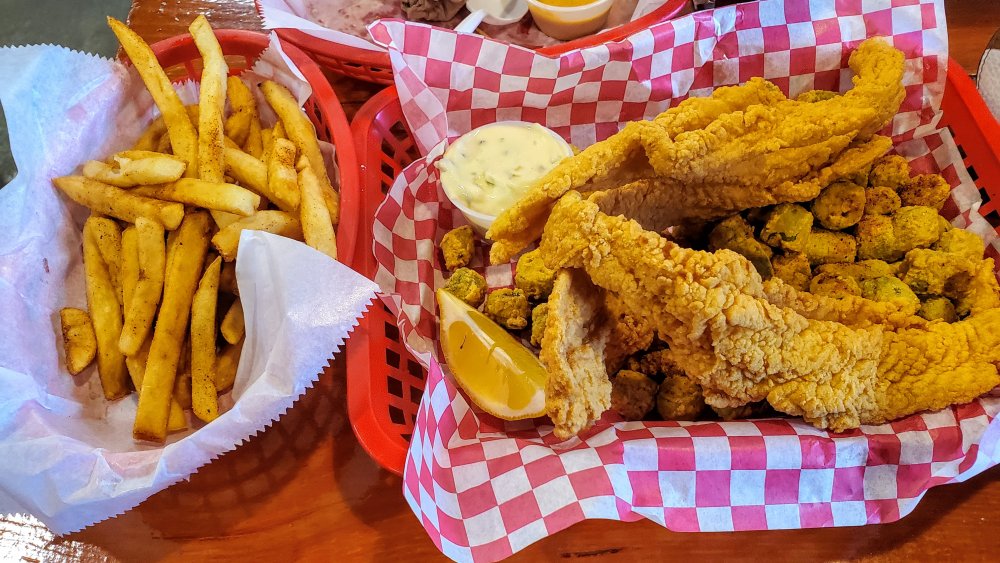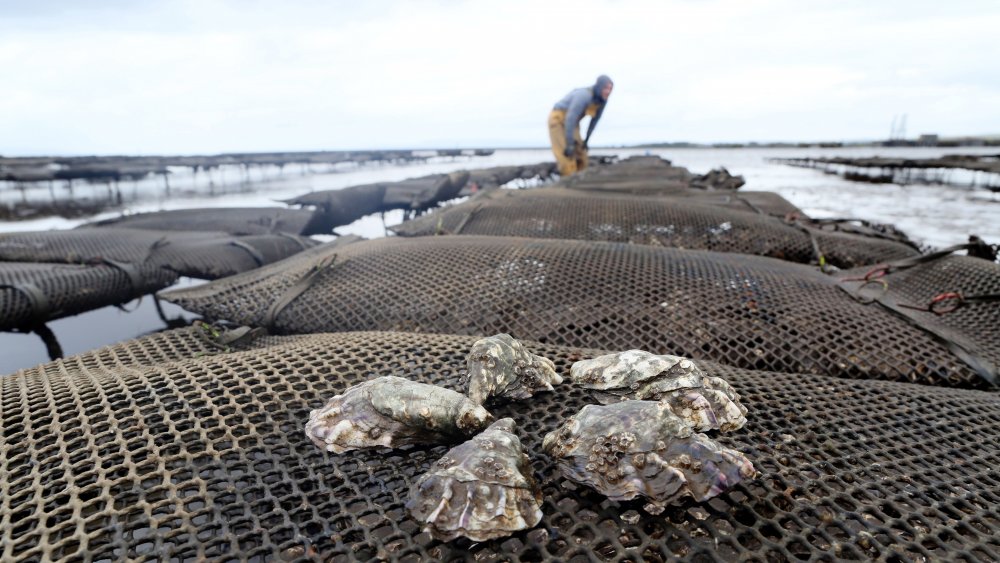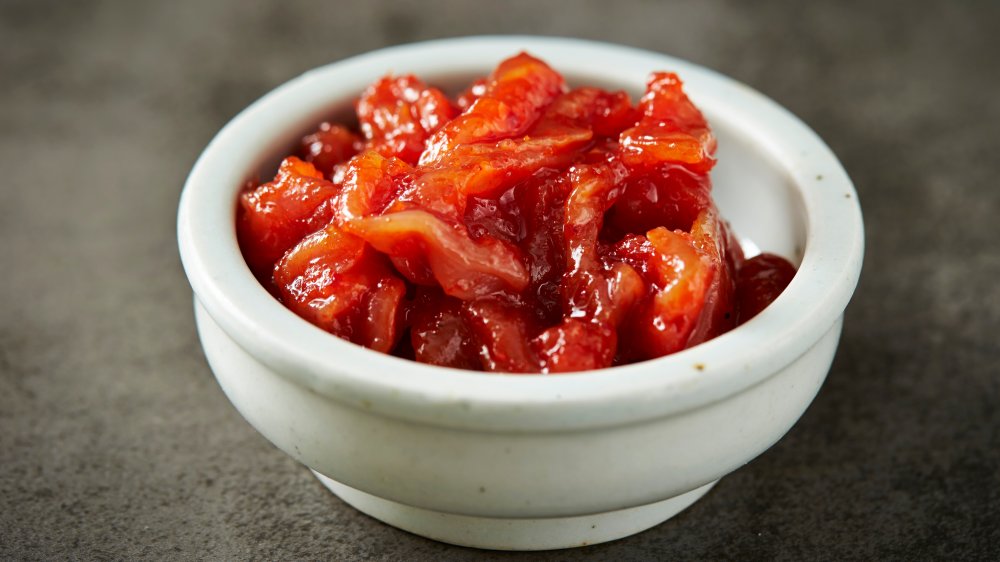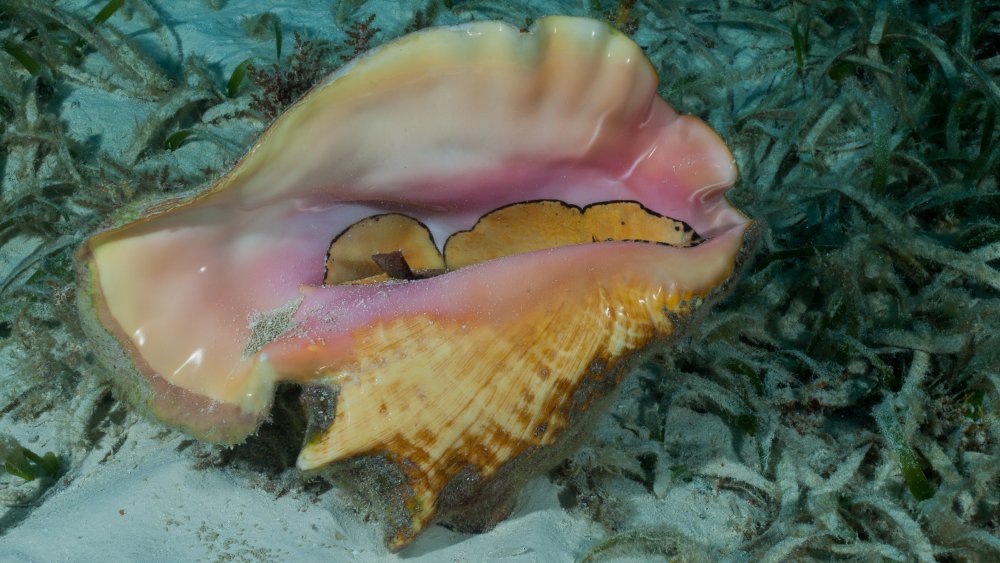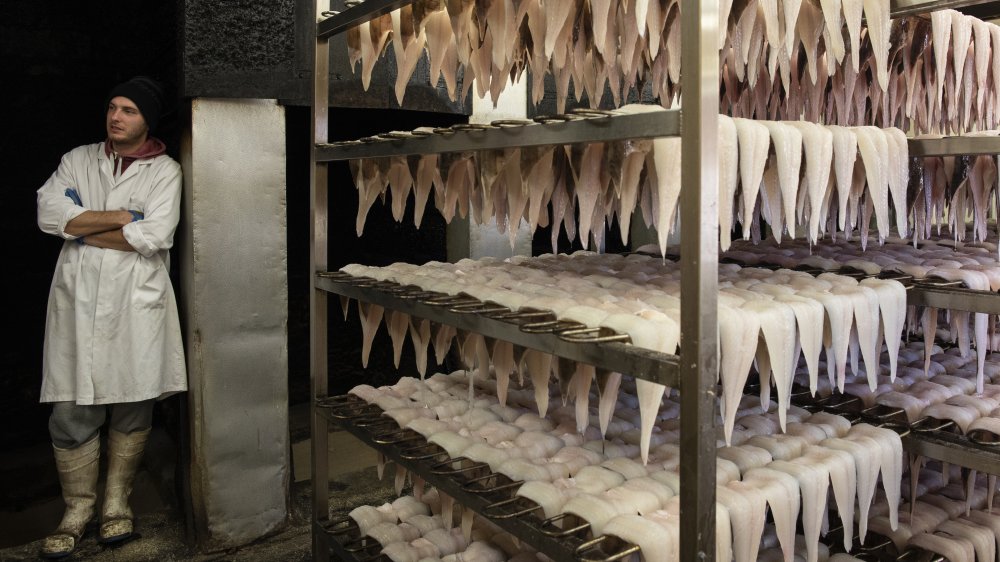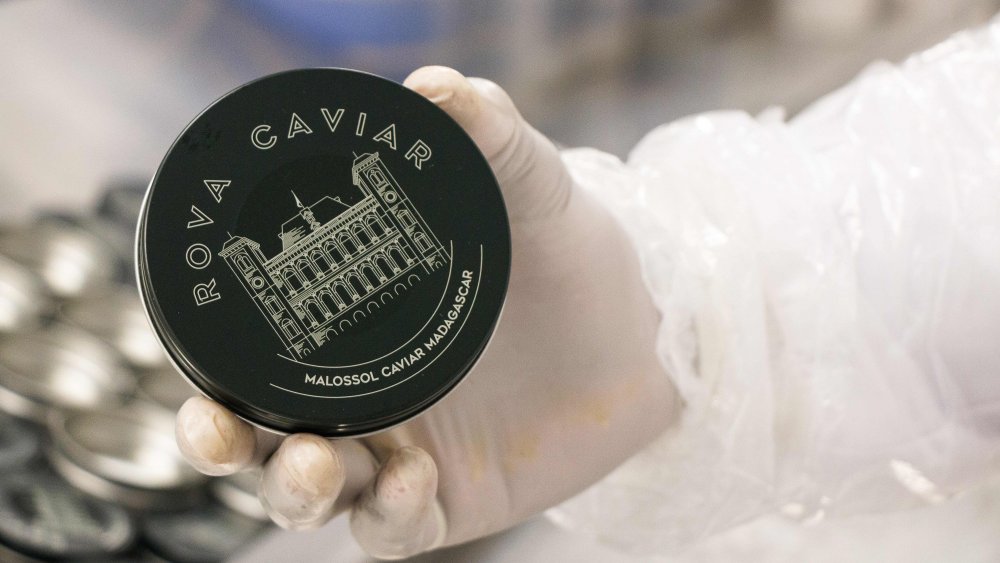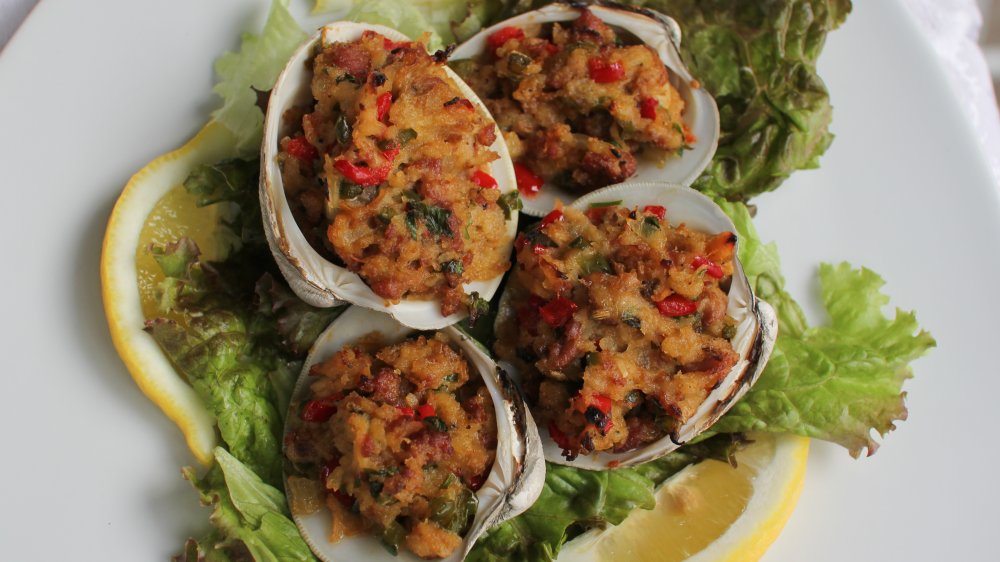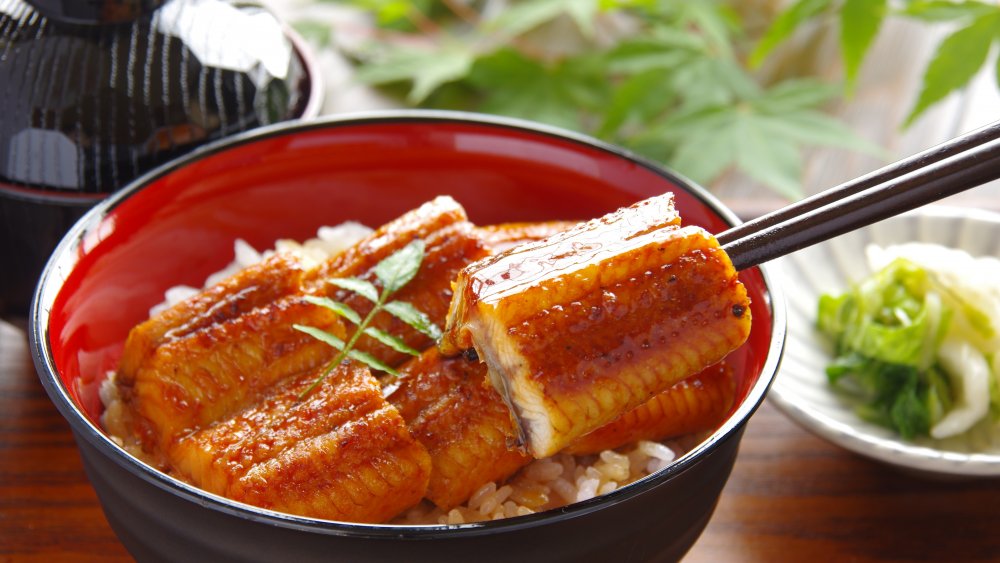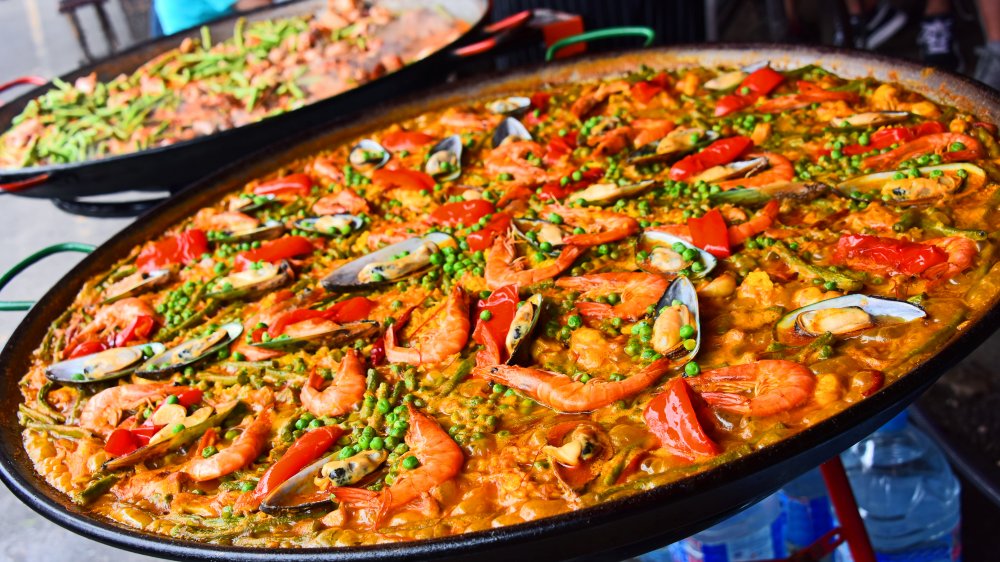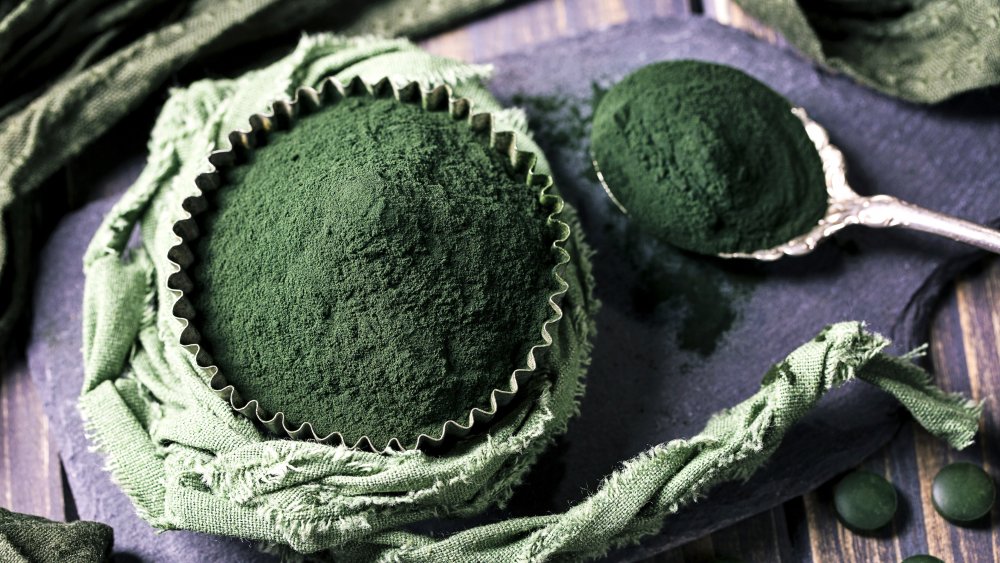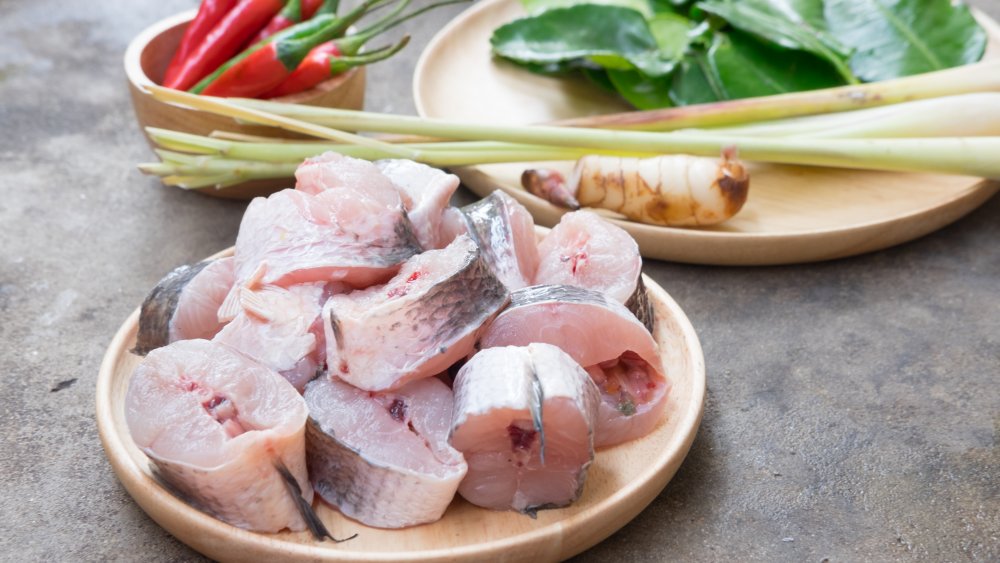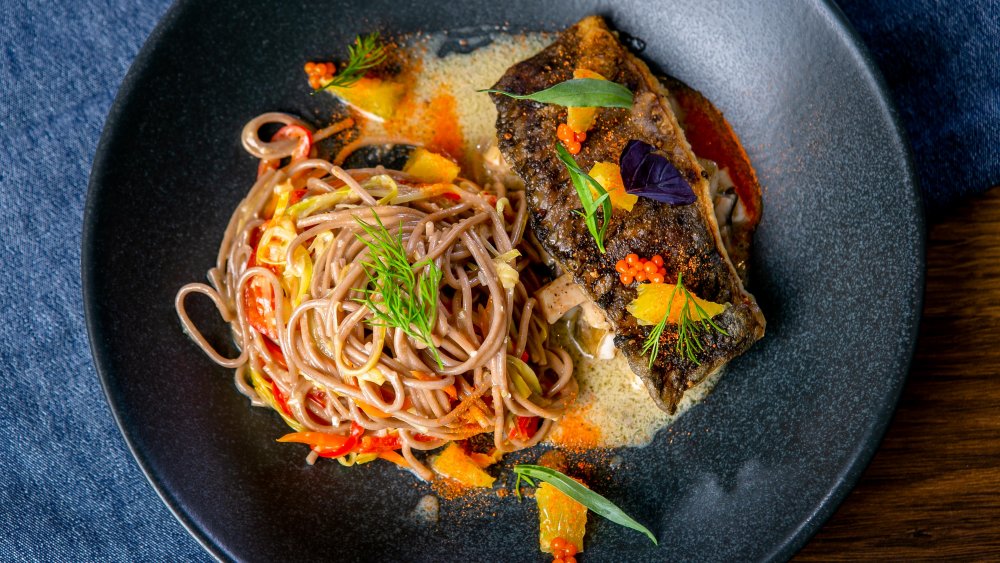27 Seafood Items You Need To Try Before You Die
When you go out to a restaurant, do you go for the tried-and-true favorites, or something new? Even if you're the type that regularly experiments with new kinds of food, seafood can be something entirely different and very intimidating, especially if you don't know what you're in for.
It's very, very polarizing — there's not too much that's just sort of "all right," and there's a lot of fish that are a love or hate sort of thing. Even if you're a fan of, say, a beer-battered fish fry, the idea of opting for something with tentacles is a whole different thing. So when you go out to eat and see some new, sometimes unfamiliar fish on the menu, is it a risk you're willing to take?
Don't worry! We're here to help. We've put together a list of fishy delights that you really should try at least once in your life. And who knows — you might just find a new favorite!
Osetra caviar
Caviar is one of those things that every foodie should be able to say they've tried, but if the idea of eating fish eggs makes you pause and rethink your approach to eating, there's good news: there's one kind of caviar in particular that's perfect for getting your feet wet. That's osetra caviar, and you're going to want to try this one in particular because it's a great, entry-level sort of caviar... while still being delicious. It's often described as being more along the lines of mild, nutty, and buttery as opposed to being overwhelmingly briny or fishy, and it's got a texture that's usually more on the firm side.
You can also pick up osetra caviar for a fairly reasonable price, especially when compared to other types. And here's the thing — get it at a restaurant, and you'll be paying a premium. But you can order it from numerous places online, and try it right from the comfort of your own home with no special knowledge required. That's one way to fancy up some nighttime snacks!
Real Maine lobster
Even if you've had lobster before, you haven't really had lobster until you've tried Maine lobster. Why? Lobsters raised in the waters off the coast of Maine are technically the same species as other types — like Canadian lobsters — but their environment produces particularly delicious meat that's sweeter and more tender than creatures raised in other waters. Maine lobsters also have slightly softer shells than their Canadian counterparts, and when you order by the pound, you're going to be getting more meat on a Maine lobster. That's definitely a win, along with the fact that Maine lobsters are strictly regulated to ensure their continued survival as a species.
If you want to make sure you're getting the real deal, you'll have to ask: according to Maine Lobster Now, it's Canadian lobsters that make up the majority of what's sold in grocery stores.
Seaweed you've picked yourself
Seaweed might be the last thing you think of when you think seafood, but it's something you should definitely think about picking up at the grocery store... or, even better, picking yourself if you happen to be lucky enough to live along the coast.
Everything about seaweed is amazing: it's full of vitamins and minerals (including iodine, which our bodies can't make on their own), it's heavy on the antioxidants, and it's been shown to help you maintain gut health and a healthy weight (via Healthline).
And there's more good news. Head to the shore, and you'll find so many different varieties of seaweed. They're all going to require different methods of cooking and prep, says The Guardian, but it's easy enough to gather a year's worth of snacks in a single afternoon. Not too bad, considering how pricey it can be in the store, right? (Just be sure to read up on the right way to harvest it, and make sure your beach isn't protected.)
Swordfish steak
Love meat, but think you should be eating more fish? Order the swordfish steak, and you'll be getting the best of both worlds.
There's a reason swordfish is sold in steak form, and it's pretty much perfect for anyone who's on the fence about fish. It's not fishy in the least, has a firm texture that's definitely meat-like, and it'll satisfy the cravings of the most stubborn carnivore while still delivering all the health benefits of fish.
It's also a good choice if you're looking to be more responsible with your meal choices. According to the NOAA, swordfish was critically over-fished in the mid-1990s. But that led to a reexamining of fishing guidelines and today, swordfish is one of the most sustainable fish you can order. Seafood Watch says to opt for swordfish caught in the North Atlantic or in the Pacific Oceans, and it might just be what you look for on every menu.
Salmon from Ireland
If you love salmon (and who doesn't?), you need to try some of the best salmon in the world. Surprisingly, that's the salmon from Ireland.
Atlantic salmon are native to the country, and between spring and autumn, they can be found in most rivers. Even those visiting Galway can catch a glimpse of wild salmon in the Weir and swimming beneath the Salmon Weir Bridge, and Irish America says somewhere around 180,000 people head to Ireland each year to cast their rod and reel in a salmon.
Even their farmed salmon is among the best in the world. Why? Salmon farms set up on the west coast are subject to extreme tidal conditions, which means the fish are constantly swimming against currents, similar to the conditions wild salmon are raised in. It's not entirely surprising to hear that Irish salmon is a must: the salmon pops up again and again in Irish mythology, and has been a staple food for thousands of years.
Uni
Seeing uni on a menu might give you pause, but you really should give it a try at least once. But first, you should also know that it's a very specific part of the sea urchin, and here's the bit that could be a potential deal breaker for some. In the spirit of full disclosure, though, uni is the part of the sea urchin that produces roe... so in other words, it's the creature's reproductive organs.
But wait! Order this delicacy (and you'll probably only find it in a sushi restaurant or specialty grocer), and you're helping to support a pretty neat industry. They're almost always harvested by hand, and those hands typically belong to one of a group of specially-trained "sea women," who spend their days diving and gathering sea urchins and other creatures to sell and support their families.
If that's not enough of a reason, Food & Wine says it's traditionally been seen as an aphrodisiac... and while it's definitely an acquired taste, at least you'll be able to say you tried it!
Sea cucumbers
The sea cucumber definitely isn't going to win any beauty contests, although there are some of the more than 1,400 different species that are pretty neat-looking. Appetizing, though? Not exactly... so hear us out.
According to Business Insider, some types are considered such delicacies that they cost more than $3,000 a kilo, and dozens of people have died diving for them — usually from decompression sickness. Part of what makes them so valuable is their high fucosylated glycosaminoglycan content, which is a huge word for a chemical known to alleviate joint problems.
There's another reason to start eating them, too — or at least give them a try. In 2019, the Marine Stewardship Council certified the world's first sustainable sea cucumber fishery, and that's not only important as a food source. Sea cucumbers feed on organic waste and help keep oceans clean — eat more, the industry will continue to grow, and that's good for us and the planet.
Lionfish
If you see lionfish on a menu, that's probably going to give you pause. Aren't they poisonous? Not exactly — they're venomous, but as long as they're properly prepared, they're perfectly safe to eat. They're pretty tasty, too, but there's another reason you should try it: you'd be doing the world's oceans a favor.
That sounds unlikely, but it's true. Lionfish are native to the Indian Ocean and the South Pacific, but in the 1990s, they started showing up off the Florida coast. They're incredibly prolific breeders, spread to extreme depths, and devastate the native ecosystems they invade. According to Stanford Center for Ocean Solutions marine scientist Stephanie Green (via Oceana), one of the best ways to protect these ocean habitats is to organize large-scale lionfish hunts — and one of the best ways to make those more popular is to create a market for lionfish as a food. So, eat up!
Blue crab
You hear all about king crab and snow crab, but what about blue crab? If you've never had this particular kind of crab, you need to try it. It's delicious! How delicious? Just take its scientific name, Callinectes sapidus. Coastal Living says that means "savory beautiful swimmer," and what more proof do you need?
Blue crabs are among the most widely harvested of all sea creatures, and they're still pricey enough. They have a large natural habitat, but in some places — particularly in the Mediterranean and in Egyptian waters — they're an invasive species. That means you're doing the oceans a favor by ordering them, so look at it that way!
While they are an important part of native ecosystems and over-fishing does have a negative impact on their native waters, Oceana says there are strict regulations placed on fishing — so when you see them on a menu, you can order with a clear conscience.
A true bouillabaisse
This one's a little tricky: when you see bouillabaisse on menus, most of the time that's just a sort of fishy soup. Even in Marseille, France, bouillabaisse has become a little less than traditional, and when New York Times journalist Elaine Sciolino headed there to find the real thing, she found it wasn't as easy to find as she thought. She needed to talk to the locals, who asked a chef for a favor, and then, there was the drive out to a small fishing village on the coast.
But it was totally worth it... at the same time it was described as an "acquired taste," it was also something more akin to an artistic experience than simply a meal. The authentic version was made from five different kinds of fresh rockfish, tomatoes, olive oil, fennel, and spices like turmeric and saffron — and it was worth the trip.
Arbroath Smokies
We're all pretty familiar with the idea that true Champagne can only be produced in the Champagne region, but did you know there's a fish version of this? They're called Arbroath Smokies, and according to the same European laws that protect true Champagne, they can only be produced within five miles of the town center of Arbroath, Scotland.
They're essentially smoked haddock, but they're still smoked in the same way they have been since the 1800s. Instead of thin slices, they're served up in fillets that are golden brown on the outside and creamy on the inside. You'll have to order these online if you want the real thing, or heck, you were just looking for a reason to go to Scotland, right?
Seafood jambalaya
There are some dishes that when they're made right, you can taste the atmosphere of that place they're from. That's definitely the case with jambalaya — made right, it's the perfect mix of Spanish- and French-inspired flavors that are pretty much New Orleans on a plate.
Whether you've always wanted to go there, wish for the day you're going back, or if you're there already, seafood jambalaya is the thing to order if you're looking for the ultimate in southern comfort food. There's no one right way to make this, but there are a few things you should look for: traditional Spanish and French spices, andouille sausage, and the seafood. Ever wish you could try crawfish the way they were meant to be enjoyed? Order the jambalaya.
Gravadlax
If you're a seafood fan, you may have had lox. It's delicious on a bagel, but if you pick up this one at the grocery store, it's probably pretty expensive. Good news! There's a much more affordable version, and it's called gravadlax.
Sometimes it's called gravlax, and if you see that at the grocery store or on an appetizer menu, try it! It's essentially a fancy name for cured salmon. Unlike lox, it's not cold-smoked — according to Serious Eats, it's even better if you make it yourself. While ordering it might net you a cheaper but just-as-tasty version of lox, picking up a salmon filet and curing it with salt, sugar, and a mix of spices over the course of a few days might just be even better. Try it once, and you never know — you might be making your own on a regular basis. Breakfast will never be the same!
Garum
You may have had garum without even knowing it: The Guardian calls it "a modern-day secret ingredient," and says it's sometimes called colatura di alici. If you see this pop up in a description, you should absolutely order the dish. Why? You're sampling something that was originally ancient Rome's most popular condiment.
According to National Geographic, the ancient Romans used this in everything from pork and fish dishes to their wine. That's right! It was in such high demand that the supply chain shaped a network of trade routes that sprawled across the ancient world; it was made along the coast with the freshest of fish... well, with the guts of those fish, to be more specific. Not only did it use up parts of the fish that might have otherwise gone to waste, it was fermented into something salty, tangy, and briny — something our modern taste buds can still appreciate. No waste!
Fried catfish
Everything's better when it's fried, right? Catfish is definitely no exception, and for anyone who's looking for some authentic southern comfort food, this is the way to go... even though it just sounds like one of those things that wouldn't be that great. Catfish might have a reputation as a bottom-feeder, but give it a chance: it's a mild fish with firm flesh that holds up well to being fried, and giving this one a try is about more than just picking something that's tasty, it's about picking something that environmentally responsible, too.
According to Seafood Watch, domestic, farm-raised catfish is a great option for anyone who wants to try something that's not going to have a negative impact on our delicate ecosystems. And that's a win all around.
Irish oysters
Oysters are definitely a love-or-hate sort of thing, and if you love them, you need to try the oysters that Bloomberg calls the best in the world. To find them, you'll have to look to Ireland, and the perfect time to go there is in September, for the Galway International Oyster & Seafood Festival.
It's no coincidence that the festival is held in the fall — it's only then that the native, flat, wild Atlantic oysters are available. They're harvested after they spawn and they last, well, as long as they last, and then they're gone until the next year. There are dozens of oyster suppliers around the country, but take Kelly Oysters — they harvest beds that have yielded shellfish for more than 4,000 years. Best of all? The different environments around the country produce oysters that taste very different to the connoisseur, so you could very literally take an oyster-based tour around the Emerald Isle... as long as you time it right.
Jeotgal
If you see a dish described as being made with jeotgal, do you order it? You should!
First, here's what you're eating: it's a traditional Korean condiment that's been around for thousands of years. According to the Journal of Ethnic Foods, it was once a valuable part of ancient rites and ceremonies — today, it's not quite as specialized, but it is still quite delicious! There are different varieties of jeotgal, and according to Chef's Society, this fermented sauce is commonly made from shrimp, squid, oysters, roe, and shellfish. And, because it's fermented, it isn't just adding some tastiness to a dish, it's adding some serious health benefits, too.
According to the BBC, fermented foods don't just help with digestion, but they help boost the immune system and balance the delicate system of bacteria that lives in our gut. Try jeotgal once, and you might just find yourself on the lookout for it whenever you peruse a seafood menu.
Conch
We're all familiar with conch shells, the impossibly gorgeous shells that aren't just known for their beauty, but for the sound they make when you blow through them. They're known for something else in the Bahamas, too: their meat.
Since the 1830s, conch meat has been a staple source of protein for those living in the Bahamas, and according to popular lore, it's also a powerful aphrodisiac. Rumor has it that islanders who have handfuls of children get them thanks to their regular conch habit, and while that's definitely not been scientifically verified, that's all right. Conch meat is high in protein, iron, and calcium, but that's a boring reason to try it. A better reason? Because it's a traditional food of the Bahamas, and let's face it, isn't walking along the beach sampling traditional seafood aphrodisiac enough?
Grimsby traditionally smoked fish
Sometimes, you just want the real thing — because nothing can come close to the original. The BBC says that it wasn't long ago that Grimsby was the biggest fishing port in the world — in spite of the fact that as far as the town went, it could best be described as "medium-sized." With all that fish going through the town's port, it's not surprising they've perfected methods of preserving it, and that includes smoking.
If you're looking for some amazing smoked fish, you need to try traditional Grimsby smoked fish. It's still made the same way it's been made for almost two centuries, and much like true Champagne can only come from the Champagne region, fish marketed as "Grimsby traditionally smoked fish" has to come from one of only five area companies. Do you need to taste what happens when an industry has generations to perfect their product? Yes, yes you do.
Rova Caviar
Love caviar? Want to try something completely unique? How about the very first caviar from Africa?
Madagascar might not be the first place you think of when you think of caviar, but according to the Robb Report, Rova caviar is going to hit the market in a big way. It's coming from a company called Acipenser, and it's a caviar farm that was founded on Lake Mantasoa in 2009. It's only in 2019 that their export numbers hit five tons per year, and even if you're not the type that has to be on top of the trendiest of trends, try this one: you'll have to go to a high-end seafood restaurant to get some, and hurry — once it's in stock, it's typically gone almost before you can blink.
Stuffed Quahog clams
We'll be completely honest: we all love food here, and we see no reason why you shouldn't plan a vacation around sampling some seriously delicious regional favorites. Take clams. If you love clams — and quahogs in particular — you need to head to Cape Cod for some stuffies.
That's the local term for stuffed quahogs, and any seafood restaurant on the Cape is going to have their own version of this local delicacy. From the secret spice blend of Arnold's Lobster and Clam Bar to the lemony flavor of Spanky's Clam Shack stuffies, all the way to the homemade, chorizo-stuffed stuffies of the family-friendly Fresh Ketch, well, let's just say that it's worth the trip just for the myriad of places offering up these super fresh clams... which are usually served alongside other, equally fresh, equally delicious seafood dishes. Yep, it just got better!
Eel
First, let's talk about the big plus to eating eel: it only has one bone. If anyone you know is leery of eating fish because of the bones — a completely legit fear — steer them toward the eel on the menu. It's super rich and super fatty, sure, but it's also super versatile and can be served in almost countless ways.
It's also entirely possible you're going to start seeing eel on more high-end menus. According to The Telegraph, smoked eel is becoming more popular on menus in restaurants that are looking for a little non-traditional luxury when it comes to their seafood menus; given that eel has been a delicacy since at least the 18th century, why wouldn't you want to give it a try?
Authentic paella
When Jamie Oliver released his recipe for "paella" and added chorizo, news outlets were reporting that Spain was unanimously outraged over his bastardization of one of their most popular traditional dishes. They take their paella very seriously, and if you only ever try one traditional Spanish dish in your lifetime, it should be the real (chorizo-free) thing.
The BBC says that while some traditional types of paella are made with meat and snails, seafood paella has become the most common. It's typically made with mussels, shrimp, and other shellfish, and you can get the real deal at restaurants across the country. Even better is the traditional setting: paella should be cooked in a large batch and shared among family and friends — often, the best paella is made from super fresh seafood in restaurants just a stone's throw from the ocean. Can you think of a better way to enjoy a meal?
Spirulina
Not all seafood is ordered off the seafood menu at a restaurant, and it's not always the biggest part of the main meal. Take spirulina. That's a type of single-celled microbe that grows in both salt and freshwater, and it has a shockingly long history. It wasn't just grown and eaten by the Aztecs, but it might also be the future of space food: NASA proposes it can be grown in space as a viable source of nutrients.
Back on Earth, it's absolutely worth picking some up. It's an ingredient rather than a dish, and according to Healthline, it's filled with antioxidants, is a known anti-inflammatory, can lower cholesterol, and may reduce blood pressure and risk of cancer. Should you pick some up next time you go to the grocery store? Absolutely — it might just change your morning smoothie game for good.
Shrimp Po'Boy
So, you're going out for a fish sandwich on a Friday night. Sure, you could opt for a boring old Filet O'Fish, or you could find a place that's a little more creative with their fish sandwiches. If there's a good restaurant nearby that specializes in southern or Louisiana cuisine, the first step is to go there, and the second is to order a Shrimp Po'Boy.
Better yet, get one in New Orleans. Sandwiches laden with delicious fried seafood — particularly shrimp and oysters — are among the most popular type of po'boy you'll find in the French Quarter, and no one does it like New Orleans. The specific sandwiches vary by place and restaurant and everyone has their favorite, but if you want a sandwich filled with some of the freshest, best fried seafood in the country, get yourself a po'boy.
Snakehead fish
Snakehead fish are a huge problem: according to the Smithsonian, these insanely ugly, slime-covered, air-breathing fish are incredibly invasive, and they've been found in waterways across the U.S. That has the potential to be devastating for native wildlife, but there's some good news: they're pretty tasty.
When The Washington Post did a side-by-side taste test, they put snakehead up against more common fish like tilapia, flounder, and cod. Snakehead came up a clear winner — in part, thanks to its lack of fishy aftertaste. The moral of the story is to give this one a try when you see it on a menu — it tastes better than it looks, and you might just help fight an invasive species.
Asian carp
In case the name isn't enough of a giveaway, it's worth mentioning that Asian carp are considered an invasive species in the U.S. HuffPo says they've spread throughout the waterways of the Mississippi and Illinois Rivers, have devastated native fish populations, and have no real predators... except for us, and that's one reason you should pick this one off the menu.
They may be listed as black carp, grass carp, bighead carp, or silver carp, and whichever one you spot, you'll have to give this one a try. Once these massive fish (they can weigh up to 100 pounds each) are on the dinner plate, they're a pretty standard sort of white fish. In many taste tests, they've been ranked as better than more popular types of white fish; it's a phenomenon Scientific American says is due in large part to the carp's ability to absorb the flavors of whatever it's cooked in. So give it a try! It's surprisingly delicious — especially when it's in something like fish tacos or potstickers.
